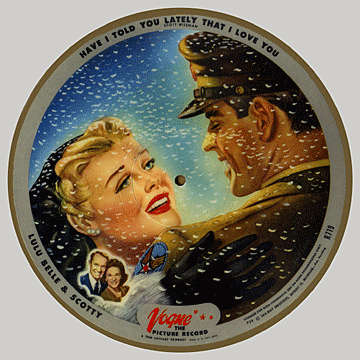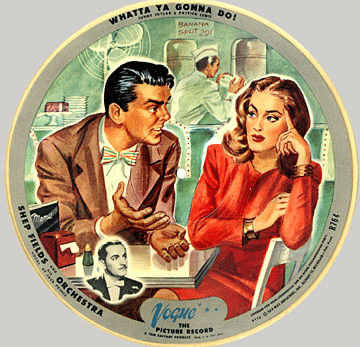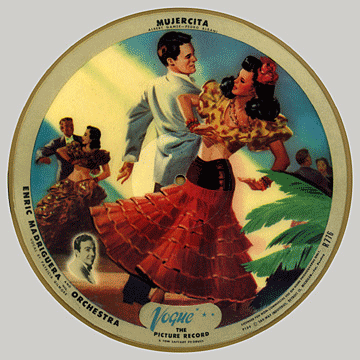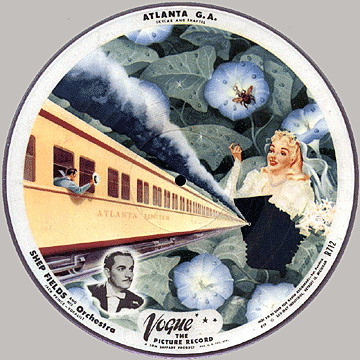|
Picture That Tune
by Bob Brooke
 It was post-war America during the
late 1940s when Sav-Way Industries of Detroit, Michigan, produced
these unique “picture” records on the “Vogue” label. From May 1946
to April the following year, Sav-Way produced 74 different, 10-inch
Vogue records. It was post-war America during the
late 1940s when Sav-Way Industries of Detroit, Michigan, produced
these unique “picture” records on the “Vogue” label. From May 1946
to April the following year, Sav-Way produced 74 different, 10-inch
Vogue records.
Sav-Way released the first 10-inch Vogue picture record in May 1946.
These records featured everything from big band to country to jazz.
Each had an artist's illustration embedded in the transparent vinyl
of the record. These illustrations, signed by the artist, on each
side of the record generally related to the title of the song on
that side. Many of the illustrations are for romantic ballads. And
while the most common Vogue picture records are 10-inch, 78 RPM
records, Sav-Way also released a few 12-inch, 78 RPM records.
 Each illustration has an "R" number, or catalog number, printed on
it, ranging from R707 to R786. However, the company didn’t use all
of the 79 catalog numbers, so there are gaps here and there. There’s
also a "P" number printed on the illustration next to the copyright
symbol. This matrix number should match the matrix number inscribed
in the lead-out area of the record. Once in a while illustrations
didn’t match the song pressed on that side of the record. Sav-Way
sometimes marked these records as Factory Rejects. But they marked
those records with damaged illustrations—torn paper or smeared
ink—as Vogue Seconds. Each illustration has an "R" number, or catalog number, printed on
it, ranging from R707 to R786. However, the company didn’t use all
of the 79 catalog numbers, so there are gaps here and there. There’s
also a "P" number printed on the illustration next to the copyright
symbol. This matrix number should match the matrix number inscribed
in the lead-out area of the record. Once in a while illustrations
didn’t match the song pressed on that side of the record. Sav-Way
sometimes marked these records as Factory Rejects. But they marked
those records with damaged illustrations—torn paper or smeared
ink—as Vogue Seconds.
 While Vogue picture records were unique and somewhat popular at
first, later on they lost favor because Sav-Way couldn’t attract
very many big-name singers and musicians. This caused the company to
re-use some previously-released songs to help fill the second side
of some records. Consequently, the catalog numbers on a particular
record may not match. Most Vogue picture record collectors know that
these records aren’t one-of-a-kind examples and don’t get excited
when they come across them. While Vogue picture records were unique and somewhat popular at
first, later on they lost favor because Sav-Way couldn’t attract
very many big-name singers and musicians. This caused the company to
re-use some previously-released songs to help fill the second side
of some records. Consequently, the catalog numbers on a particular
record may not match. Most Vogue picture record collectors know that
these records aren’t one-of-a-kind examples and don’t get excited
when they come across them.
Sav-Way sold Vogue picture records both individually, as well as in
albums containing two records. The company produced eight different
albums. Originally, the single records sold for around a dollar
while the albums sold for a little less than three dollars. Sears,
Roebuck, and Company’s 1946/47 Fall/Winter catalog offered 18
different Vogue records and seven different Vogue albums.
 Vogue picture records were of very high quality and had little
surface noise. Sav-Way produced the records using a complicated
process using a central core aluminum disc sandwiched between the
paper illustrations and vinyl. It took a while for the firm to
perfect this process. Their engineers spent several months working
out the bugs that resulted in torn or dislodged paper illustrations. Vogue picture records were of very high quality and had little
surface noise. Sav-Way produced the records using a complicated
process using a central core aluminum disc sandwiched between the
paper illustrations and vinyl. It took a while for the firm to
perfect this process. Their engineers spent several months working
out the bugs that resulted in torn or dislodged paper illustrations.
Unlike many other collectibles, Vogue picture records have a
definite beginning and end making it possible for a collector to
assemble a complete set of the records over time. However, finding
these picture records can be a challenge. Beginning collectors often
find them at yard or garage sales or flea markets for a few dollars.
More advanced collectors know to look to the Internet to find some
of the more hard-to-find examples. In the end, Vogue picture records
were a short-lived novelty which has become a fascinating
collectible.
<
Back to More Antique Spotlights
Next
Article >
|
